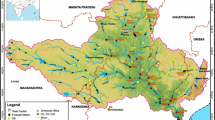Abstract
This study was undertaken to assess the heavy metal concentration of the drinking water with respect to zinc, copper, cadmium, manganese, lead and arsenic in Kamrup district of Assam, India. Ground water samples were collected from tube wells, deep tube wells and ring wells covering all the major hydrogeological environs. Heavy metals in groundwater are estimated by using Atomic Absorption Spectrometer, Perkin Elmer Analyst 200. Data were assessed statistically to find the distribution pattern and other related information for each metal. The study revealed that a good number of the drinking water sources were contaminated with cadmium, manganese and lead. Arsenic concentrations although did not exceeded WHO limits but was found to be slightly elevated. Copper and zinc concentrations were found to be within the prescribed WHO limits. An attempt has also been made to ascertain the possible source of origin of the metals. Positive and significant correlation existing between manganese with zinc and copper indicates towards their similar source of origin and mobility. In view of the present study and the level of heavy metal contamination, it could be suggested to test the potability of the water sources before using it for drinking purpose.
Similar content being viewed by others
Explore related subjects
Discover the latest articles and news from researchers in related subjects, suggested using machine learning.References
APHA (American Public Health Association) (1998). Standard method for examination of water and wastewater (20th ed.). Wahington, DC: APHA.
Borah, K. K., Bhuyan, B., & Sarma, H. P. (2009a). Heavy metal contamination of groundwater in the tea garden belt of Darrang District, Assam, India. E-Journal of Chemistry, 6(S1), 501–507.
Borah, K. K., Bhuyan, B., & Sarma, H. P. (2009b). Lead, Arsenic, fluoride, and iron contamination of drinking water in the tea garden belt of Darrang district, Assam, India. Environmental Monitoring and Assessment, 169(1–4), 347–352. doi:10.1007/s10661-009-1176-2.
Buragohain, M., Bhuyan, B., & Sarma, H. P. (2010). Seasonal variations of lead, arsenic, cadmium and aluminium contamination of groundwater in Dhemaji district, Assam, India. Environmental Monitoring and Assessment, 170(1–4), 345–351. doi:10.1007/s10661-s10661-009-1237-6.
Chakraborti, D., Rahman, M. M., Paul, K., Choudhury, U. K., Sengupta, M. K., Lodh, D., et al. (2002). Arsenic calamity in the Indian subcontinent: What lessons have been learned? Talanta, 58(1), 3–22.
Chetia, M., Singh, S. K., Bora, K., Kalita, H., Saikia, L. B., Goawami, D. C., et al. (2008). Groundwater arsenic contamination in three blocks of Golaghat district of Assam. Journal of Indian Water Works Association, 40(2), 150–154.
Das, B., Rahman, M. M., Nayak, B., Pal, A., Chowdhury, U. K., Mukherjee, S. C., et al. (2009). Groundwater arsenic contamination, its health effects and approach for mitigation in West Bengal, India and Bangladesh. Water Qual Expo Health, 1, 5–21.
Friberg, L., Nordberg, G. F., & Vouk, V. B. (1986). Handbook of the toxicology of metals (Vol. 2, pp. 30–184). Amsterdam: Elsevier.
Mahanta, C. (2006). Water resources in the northeast: State of the knowledge base; This paper was commissioned as an input to the study “Development and growth in Northeast India: The natural resources, water, and environment nexus”.
Mukherjee, A., Sengupta, M. K., Hossain, M. A., Ahmed, S., Das, B., Nayak, B., et al. (2006). Arsenic contamination in groundwater: A global perspective with emphasis on the Asian scenario. Journal of Health Population and Nutrition, 24(2), 142–163.
Nickson, R. T., McArthur, J. M., Ravenscroft, P., Burgess, W. G., & Ahmed, K. M. (2000). Mechanism of arsenic release to groundwater, Bangladesh and West Bengal. Journal of Applied Geochemistry, 15(4), 403–413.
Sia Su, G. L. (2007). Impact on drinking water sources in close proximity to the Payatas dumpsite, Philippines. J Pub health, 15, 51–55.
Singh, A. K. (2004). Arsenic contamination in groundwater of North Eastern India. Proceedings of national seminar on hydrology held at National Institute of Hydrology, Roorkee.
SOES (2004). Groundwater arsenic contamination in North Eastern states, India. The School of Environmental Studies, Jadavpur University. http://www.soesju.org/arsenic/north_east.htm. Accessed 28 Feb 2010.
WHO (2004). Guidelines for drinking water quality (3rd ed.). Geneva: World Health Organisation.
WHO/UNEP GEMS (1989). Global fresh water quality. Oxford: Blackwell (published on behalf of the World Health Organization/United Nations Environment Programme).
Author information
Authors and Affiliations
Corresponding author
Rights and permissions
About this article
Cite this article
Chakrabarty, S., Sarma, H.P. Heavy metal contamination of drinking water in Kamrup district, Assam, India. Environ Monit Assess 179, 479–486 (2011). https://doi.org/10.1007/s10661-010-1750-7
Received:
Accepted:
Published:
Issue Date:
DOI: https://doi.org/10.1007/s10661-010-1750-7




